Combustion Performance and Low NOx Emissions of a Dimethyl Ether Compression-Ignition Engine at High Injection Pressure and High Exhaust Gas Recirculation Rate
Abstract
:1. Introduction
2. Experimental
2.1. Fuel Properties
2.2. Engine System
2.3. Experimental Procedure
3. Results and Discussion
3.1. Injection Pressure
3.2. Exhaust Gas Recirculation (EGR)
4. Conclusions
- (1)
- The physical and chemical properties of DME (high cetane number, oxygen content, and evaporation rate) are the principal determinants of the combustion characteristics. The short ignition delay and fast combustion speed of DME ensure combustion efficiency regardless of the operation conditions, injection pressure, or EGR rate. At a high EGR rate, DME combustion efficiency is reduced slightly to 2%, and a high injection pressure does not improve DME combustion.
- (2)
- Increased injection pressure induces higher combustion temperature and lower combustion efficiency of DME and ULSD. Thus, NOx emissions are increased up to 91% at high injection pressures for DME fuel. However, for DME engines, a high injection pressure is not necessary to achieve high combustion efficiency or reduce emissions. A lower injection pressure provides both high performance and low engine-out emissions.
- (3)
- A high EGR rate when using DME ensures low levels of combustion-produced NOx emissions with a reduction of 73% in the combustion chamber, with no loss of combustion efficiency. The soot emissions are extremely low regardless of the injection pressure [4,20] or EGR rate. At a high EGR rate could greatly facilitate the use of eco-friendly DME-fueled CI engines.
Author Contributions
Funding
Institutional Review Board Statement
Informed Consent Statement
Data Availability Statement
Conflicts of Interest
Abbreviations
| ABDC | after bottom-dead-center |
| BBDC | before bottom-dead-center |
| ATDC | after top-dead-center |
| BTDC | before top-dead-center |
| CAD | crank angle degree |
| DME | dimethyl ether |
| EGR | exhaust gas recirculation |
| HRR | heat release rate |
| ISFC | indicated specific fuel consumption |
| ITE | indicated thermal efficiency |
| Pinj | injection pressure |
| TDC | top-dead center |
| τinj | injection timing |
| ULSD | ultra-low-sulfur diesel |
References
- Wróblewski, P.; Koszalka, G. An Experimental Study on Frictional Losses of Coated Piston Rings with Symmetric and Asymmetric Geometry. SAE Int. J. Eng. 2021, 14, 853–866. [Google Scholar] [CrossRef]
- Wróblewski, P. Technology for Obtaining Asymmetries of Stereometric Shapes of the Sealing Rings Sliding Surfaces for Selected Anti-Wear Coatings; No. 2020-01-2229; SAE International: Warrendale, PA, USA, 2020. [Google Scholar]
- Shi, L.; Ji, C.; Wang, S.; Cong, X.; Su, T.; Shi, C. Impacts of dimethyl ether enrichment and various injection strategies on combustion and emissions of direct injection gasoline engines in the lean-burn condition. Fuel 2019, 254, 115636. [Google Scholar] [CrossRef]
- Anubhav, N.K.; Saluja, R.K. Optimization of Fuel Injection Strategies for Sustainability of DME in Combustion Engine. In Greener and Scalable E-Fuels for Decarbonization of Transport; Agarwal, A.K., Valera, H., Eds.; Springer: Singapore, 2022; pp. 293–314. [Google Scholar]
- Gharehghani, A.; Kakoee, A.; Andwari, A.M.; Megaritis, T.; Pesyridis, A. Numerical Investigation of an RCCI Engine Fueled with Natural Gas/Dimethyl-Ether in Various Injection Strategies. Energies 2021, 14, 1638. [Google Scholar] [CrossRef]
- Mehra, S.; Agarwal, A.K. Prospects and Challenges of DME Fueled Low-Temperature Combustion Engine Technology. In Greener and Scalable E-Fuels for Decarbonization of Transport; Agarwal, A.K., Valera, H., Eds.; Springer: Singapore, 2022; pp. 261–291. [Google Scholar]
- Jeon, J.; Kwon, S.I.; Park, Y.H.; Oh, Y.; Park, S. Visualizations of combustion and fuel/air mixture formation processes in a single cylinder engine fueled with DME. Appl. Energy 2014, 113, 294–301. [Google Scholar] [CrossRef]
- Youn, I.M.; Park, S.H.; Roh, H.G.; Lee, C.S. Investigation on the fuel spray and emission reduction characteristics for dimethyl ether (DME) fueled multi-cylinder diesel engine with common-rail injection system. Fuel Process. Technol. 2011, 92, 1280–1287. [Google Scholar] [CrossRef]
- Fabiś, P.; Flekiewicz, B. Influence of LPG and DME Composition on Spark Ignition Engine Performance. Energies 2021, 14, 5583. [Google Scholar] [CrossRef]
- Li, X.; He, B.-Q.; Zhao, H. Study on micro-flame ignited (MFI) hybrid combustion characteristics of a dual-fuel optical engine at different lambdas. Fuel 2021, 290, 119796. [Google Scholar] [CrossRef]
- Jeon, J.; Park, Y.H.; Kwon, S.I.; Park, S. Effect of Pilot Injection Timings on the Combustion Temperature Distribution in a Single-Cylinder CI Engine Fueled with DME and ULSD. Oil Gas Sci. Technol.–Rev. D’ifp Energ. Nouv. 2016, 71, 15. [Google Scholar] [CrossRef] [Green Version]
- Pham, V.C.; Rho, B.-S.; Kim, J.-S.; Lee, W.-J.; Choi, J.-H. Effects of Various Fuels on Combustion and Emission Characteristics of a Four-Stroke Dual-Fuel Marine Engine. J. Mar. Sci. Eng. 2021, 9, 1072. [Google Scholar] [CrossRef]
- Kamei, W.; Sahoo, N.; Prasad, V.V.D.N. Dimethyl Ether and Liquefied Petroleum Gas Co-Fumigation and Oxidation Catalyst Exhaust Aftertreatment: A Synergy for Improvement of Thermal Efficiency and Emissions in a Dual-Fuel Engine. J. Energy Resour. Technol. 2021, 143, 11. [Google Scholar] [CrossRef]
- Ezoji, H.; Shafaghat, R.; Jahanian, O. Numerical simulation of dimethyl ether/natural gas blend fuel HCCI combustion to investigate the effects of operational parameters on combustion and emissions. J. Therm. Anal. Calorim. 2019, 135, 1775–1785. [Google Scholar] [CrossRef]
- Lokachari, N.; Wagnon, S.W.; Kukkadapu, G.; Pitz, W.J.; Curran, H.J. An experimental and kinetic modeling study of cyclopentane and dimethyl ether blends. Combust Flame 2021, 225, 255–271. [Google Scholar] [CrossRef]
- Algayyim, S.J.M.; Wandel, A.P. Macroscopic and microscopic characteristics of biofuel spray (biodiesel and alcohols) in CI engines: A review. Fuel 2021, 292, 120303. [Google Scholar] [CrossRef]
- Sivalingam, S.; Palanisamy, P.; Baluchamy, A. Experimental investigation on Jatropha oil Methyl Ester fuelled CI engine using high EGR. Mater. Today Proc. 2021, 39, 274–278. [Google Scholar] [CrossRef]
- Shao, Z.; Wang, J.; Han, Y.; Xu, L.; Tian, J. The synergistic effect of fuel aromatic components refinement and ignition timing on GDI engine performance and emissions. Fuel 2021, 298, 120800. [Google Scholar] [CrossRef]
- Park, S.H.; Lee, C.S. Applicability of dimethyl ether (DME) in a compression ignition engine as an alternative fuel. Energy Convers. Manag. 2014, 86, 848–863. [Google Scholar] [CrossRef]
- Park, S.H.; Lee, C.S. Combustion performance and emission reduction characteristics of automotive DME engine system. Prog. Energy Combust. Sci. 2013, 39, 147–168. [Google Scholar] [CrossRef]
- Putrasari, Y.; Lim, O. Dimethyl Ether as the Next Generation Fuel to Control Nitrogen Oxides and Particulate Matter Emissions from Internal Combustion Engines: A Review. ACS Omega 2022, 7, 32–37. [Google Scholar] [CrossRef]
- Teng, H.; McCandless, J.C.; Schneyer, J.B. Compression Ignition Delay (Physical + Chemical) of Dimethyl Ether—An Alternative Fuel for Compression-Ignition Engines; SAE International: Warrendale, PA, USA, 2003. [Google Scholar]
- Thomas, G.; Feng, B.; Veeraragavan, A.; Cleary, M.J.; Drinnan, N. Emissions from DME combustion in diesel engines and their implications on meeting future emission norms: A review. Fuel Process. Technol. 2014, 119, 286–304. [Google Scholar] [CrossRef]
- Kapus, P.; Ofner, H. Development of Fuel Injection Equipment and Combustion System for DI Diesels Operated on Dimethyl Ether; SAE International: Warrendale, PA, USA, 1995. [Google Scholar]
- Suh, H.K.; Park, S.H.; Kim, H.J.; Lee, C.S. Influence of ambient flow conditions on the droplet atomization characteristics of dimethyl ether (DME). Fuel 2009, 88, 1070–1077. [Google Scholar] [CrossRef]
- Sivebaek, I.M.; Sorenson, S.C.; Jakobsen, J. Dimethyl Ether (DME)—Assessment of Viscosity Using the New Volatile Fuel Viscometer (VFVM); SAE International: Warrendale, PA, USA, 2001. [Google Scholar]
- Teng, H.; McCandless, J.C.; Schneyer, J.B. Viscosity and Lubricity of (Liquid) Dimethyl Ether—An Alternative Fuel for Compression-Ignition Engines; SAE International: Warrendale, PA, USA, 2002. [Google Scholar]
- Sorenson, S.C.; Glensvig, M.; Abata, D.L. Dimethyl Ether in Diesel Fuel Injection Systems; SAE International: Warrendale, PA, USA, 1998. [Google Scholar]
- Sezer, İ. Thermodynamic, performance and emission investigation of a diesel engine running on dimethyl ether and diethyl ether. Int. J. Therm. Sci. 2011, 50, 1594–1603. [Google Scholar] [CrossRef]
- Yu, J.; Bae, C. Dimethyl ether (DME) spray characteristics in a common-rail fuel injection system. Proc. Inst. Mech. Eng. Part D J. Automob. Eng. 2003, 217, 1135–1144. [Google Scholar] [CrossRef]
- Kim, M.Y.; Yoon, S.H.; Ryu, B.W.; Lee, C.S. Combustion and emission characteristics of DME as an alternative fuel for compression ignition engines with a high pressure injection system. Fuel 2008, 87, 2779–2786. [Google Scholar] [CrossRef]
- Teng, H.; McCandless, J.C.; Schneyer, J.B. Thermochemical Characteristics of Dimethyl Ether—An Alternative Fuel for Compression-Ignition Engines; SAE International: Warrendale, PA, USA, 2001. [Google Scholar]
- Park, S.W. Numerical Study on Optimal Operating Conditions of Homogeneous Charge Compression Ignition Engines Fueled with Dimethyl Ether and n-Heptane. Energy Fuels 2009, 23, 3909–3918. [Google Scholar] [CrossRef]
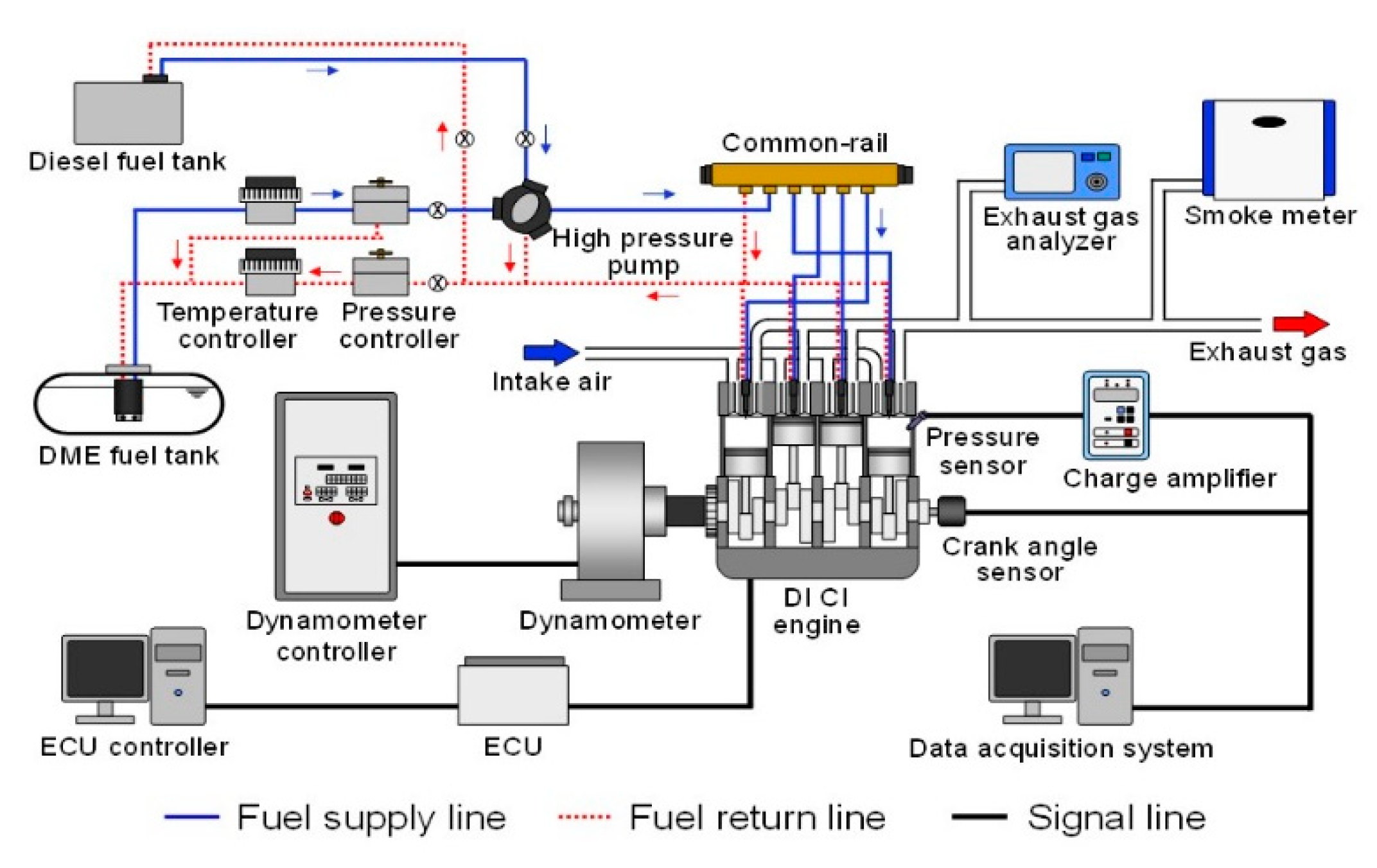
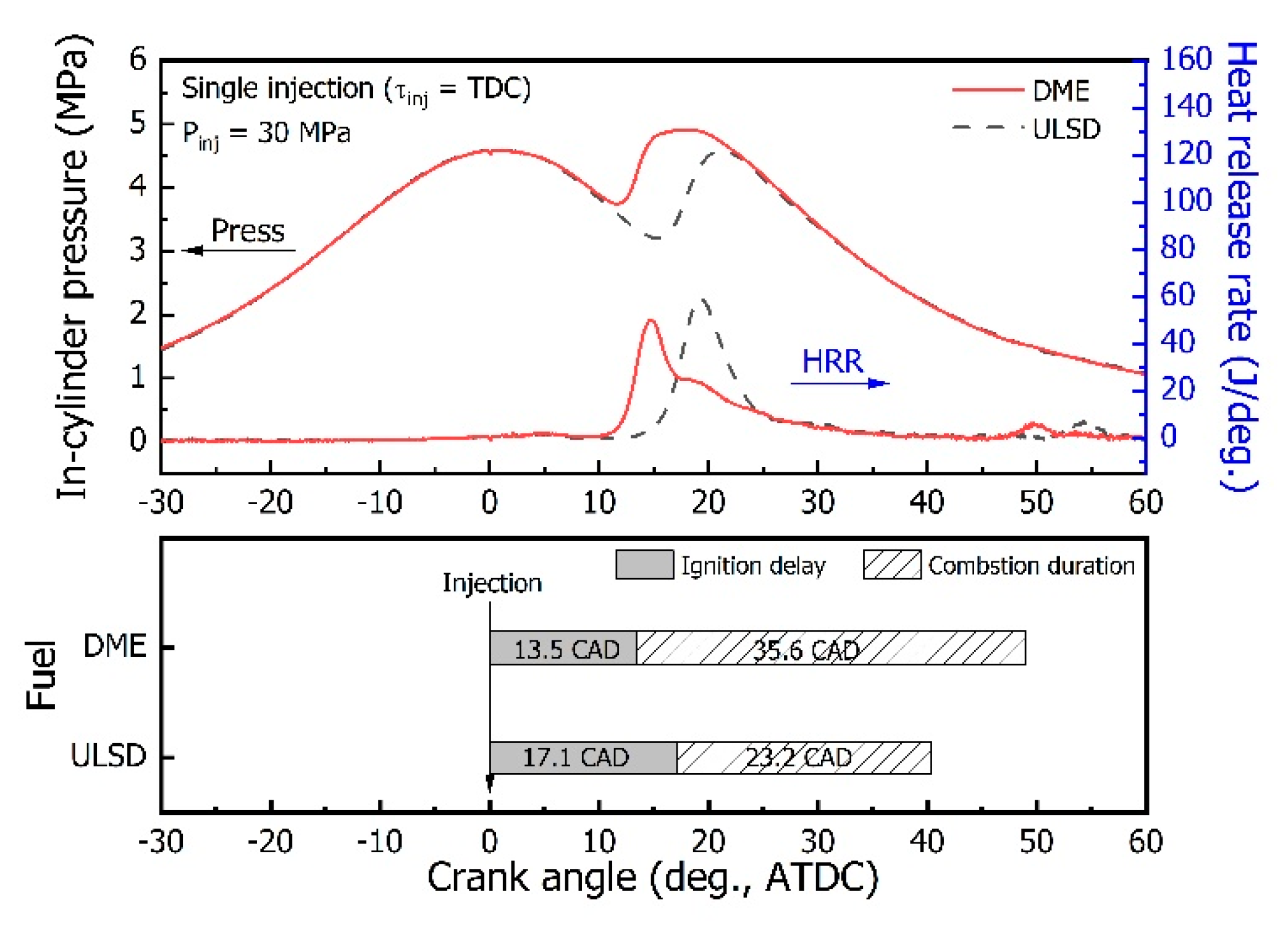
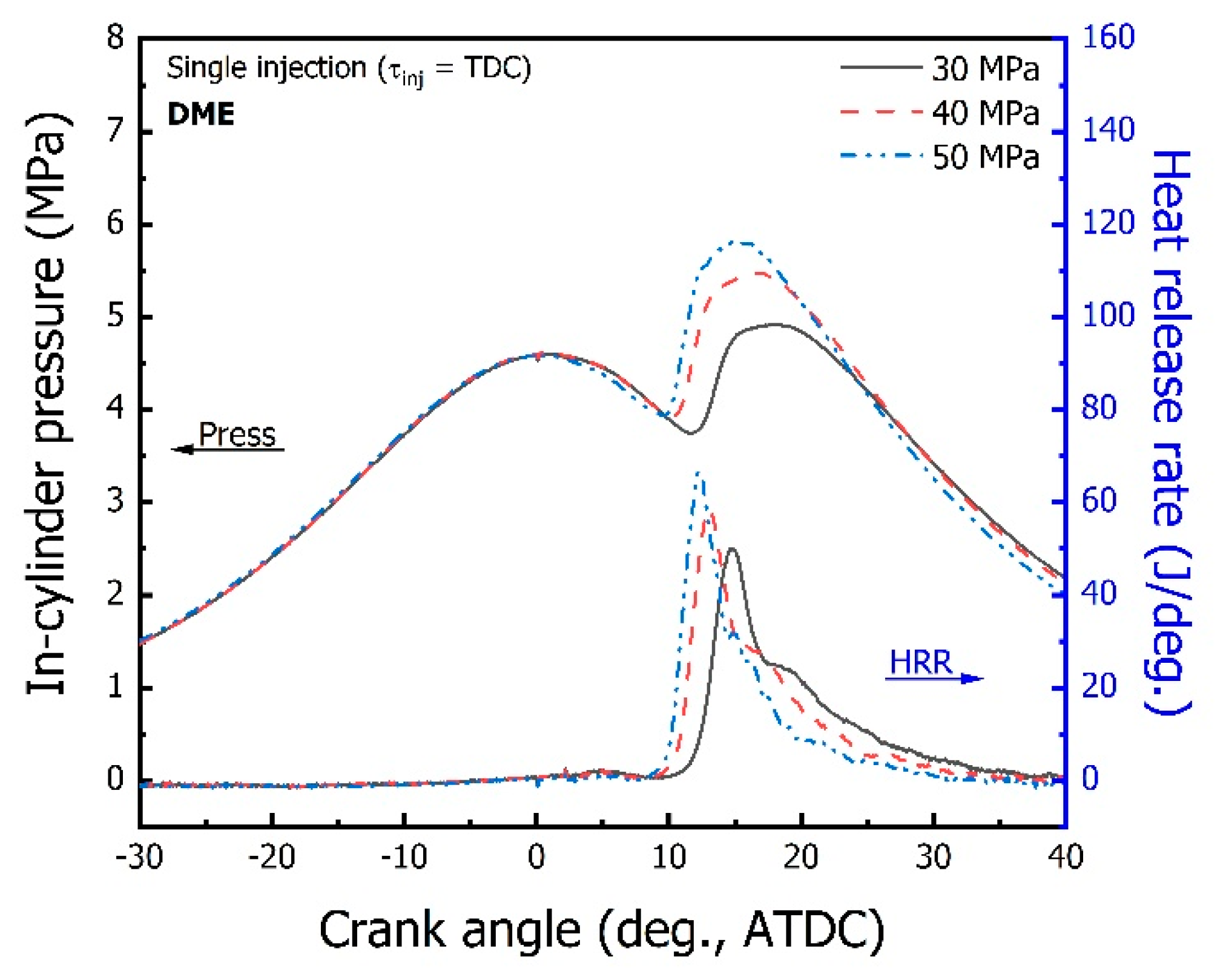



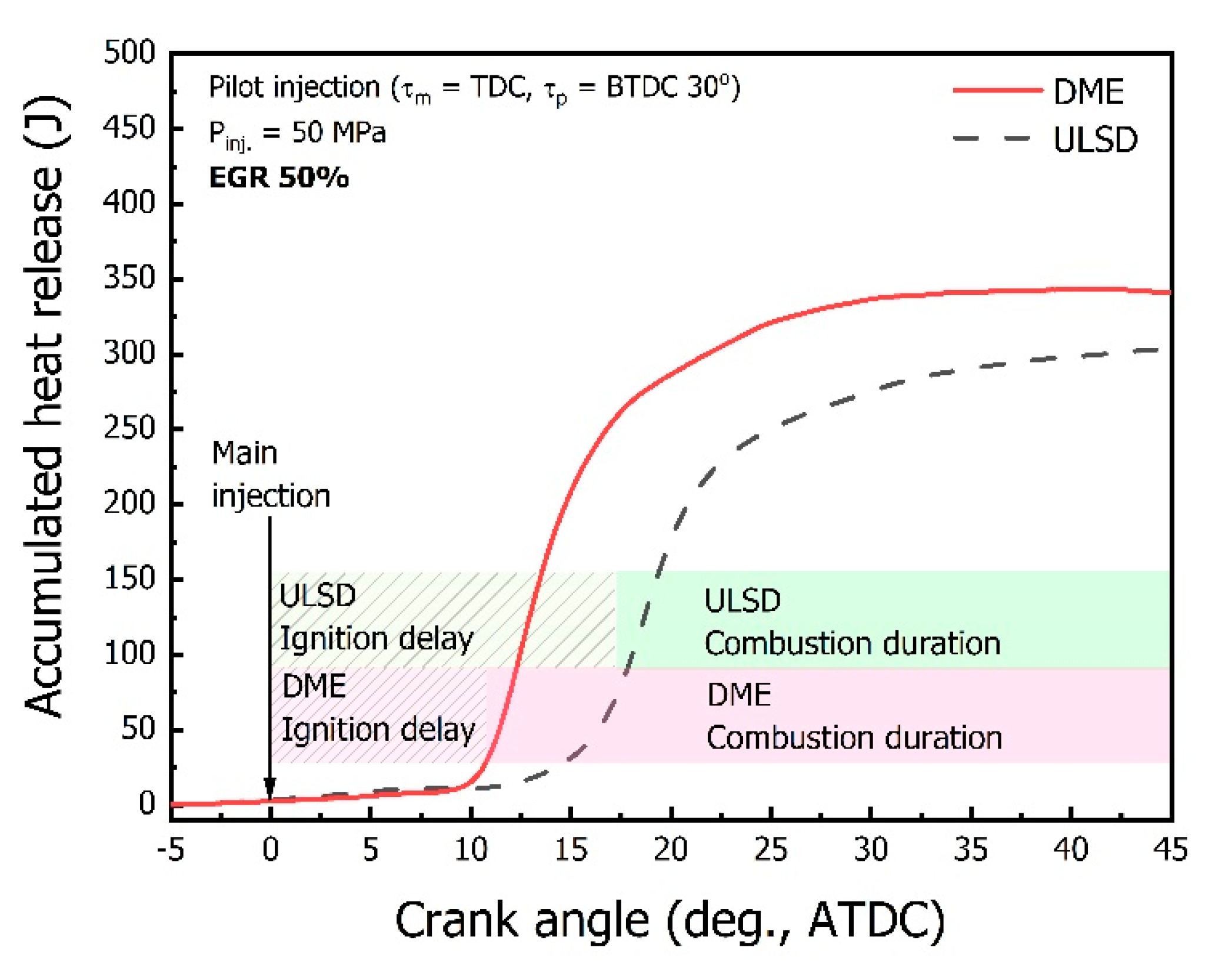
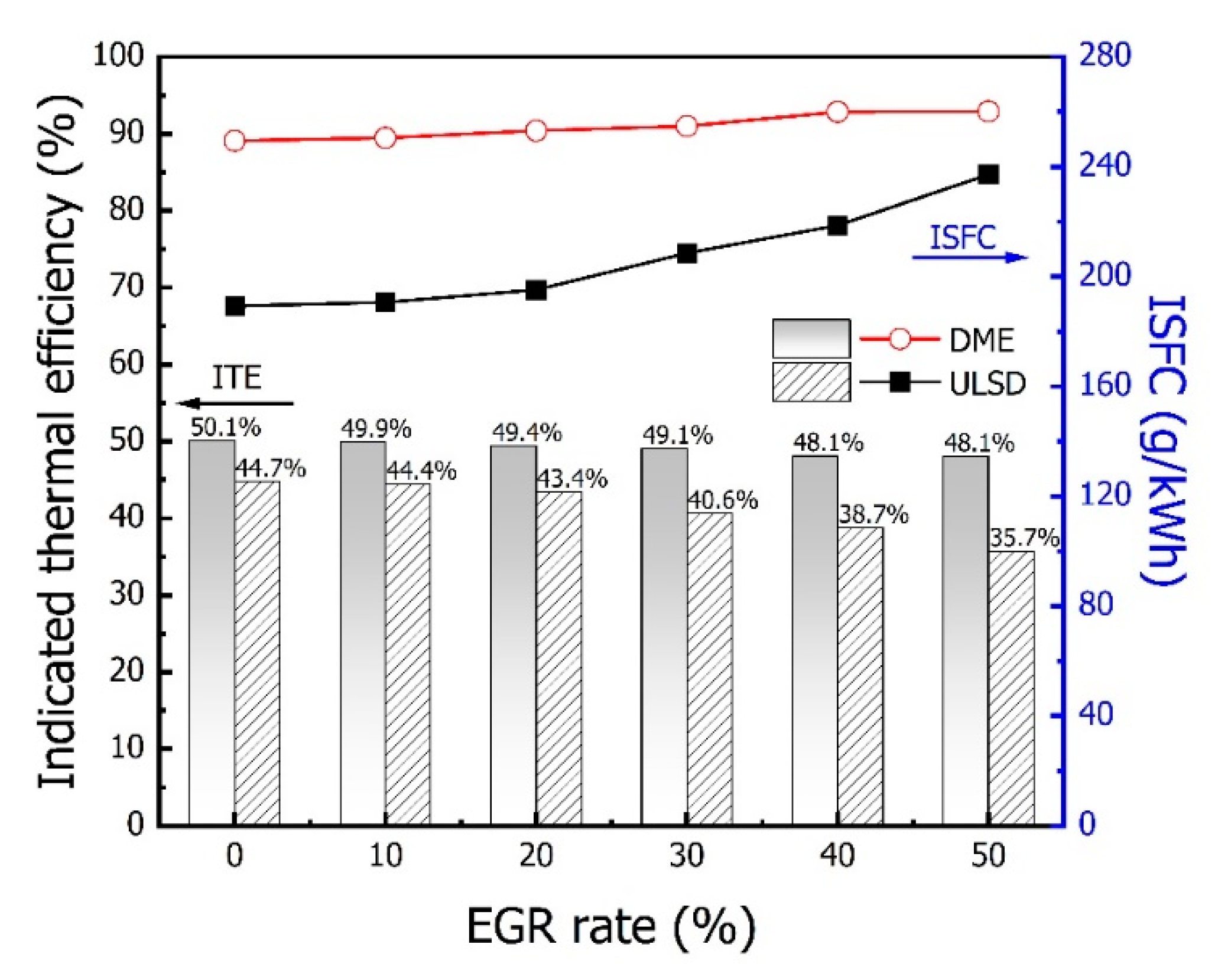
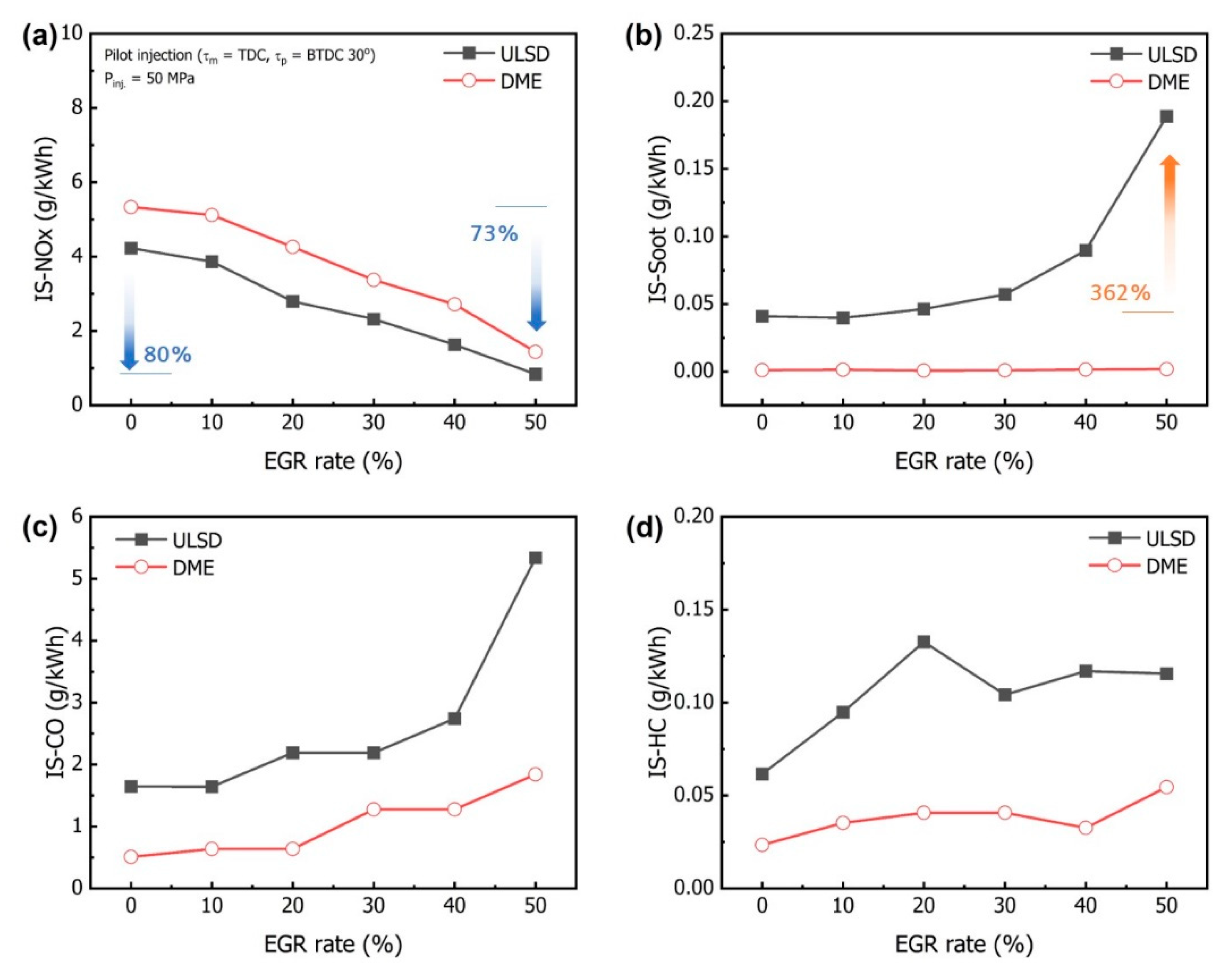
| Properties | ULSD | DME |
|---|---|---|
| Chemical formula | C8 to C25 | CH3OCH3 |
| Cetane number [22,23] | 40~55 | 55~60 |
| Oxygen contents (wt%) | - | 34.7 |
| Lower heating value (MJ/kg) [24] | 42.50 | 28.43 |
| Boiling temperature (°C) [25] | 150~380 | −25 |
| Liquid density (kg/m3 at 20 °C) | 800~840 | 670 |
| Liquid viscosity (kg/m·s at 25 °C) [26,27] | 2~4 | 0.12~0.15 |
| Vapor pressure (MPa at 25 °C) [28] | <0.001 | 0.51 |
| Latent heat of vaporization (kJ/kg) [29] | 250 | 460 |
| Description | Specification |
|---|---|
| Engine type | 4-stroke VGT DI diesel engine |
| Number of cylinders | 4 |
| Bore × Stroke (mm) | 77.2 × 84.5 |
| Displacement (L) | 1.582 |
| Compression ratio | 17.3:1 |
| Intake valve open/close | BTDC 6°/ABDC 34° |
| Exhaust valve open/close | BBDC 46°/ATDC 4° |
| Max Rail Pressure (MPa) | 160 |
Publisher’s Note: MDPI stays neutral with regard to jurisdictional claims in published maps and institutional affiliations. |
© 2022 by the authors. Licensee MDPI, Basel, Switzerland. This article is an open access article distributed under the terms and conditions of the Creative Commons Attribution (CC BY) license (https://creativecommons.org/licenses/by/4.0/).
Share and Cite
Youn, I.; Jeon, J. Combustion Performance and Low NOx Emissions of a Dimethyl Ether Compression-Ignition Engine at High Injection Pressure and High Exhaust Gas Recirculation Rate. Energies 2022, 15, 1912. https://doi.org/10.3390/en15051912
Youn I, Jeon J. Combustion Performance and Low NOx Emissions of a Dimethyl Ether Compression-Ignition Engine at High Injection Pressure and High Exhaust Gas Recirculation Rate. Energies. 2022; 15(5):1912. https://doi.org/10.3390/en15051912
Chicago/Turabian StyleYoun, Inmo, and Joonho Jeon. 2022. "Combustion Performance and Low NOx Emissions of a Dimethyl Ether Compression-Ignition Engine at High Injection Pressure and High Exhaust Gas Recirculation Rate" Energies 15, no. 5: 1912. https://doi.org/10.3390/en15051912






